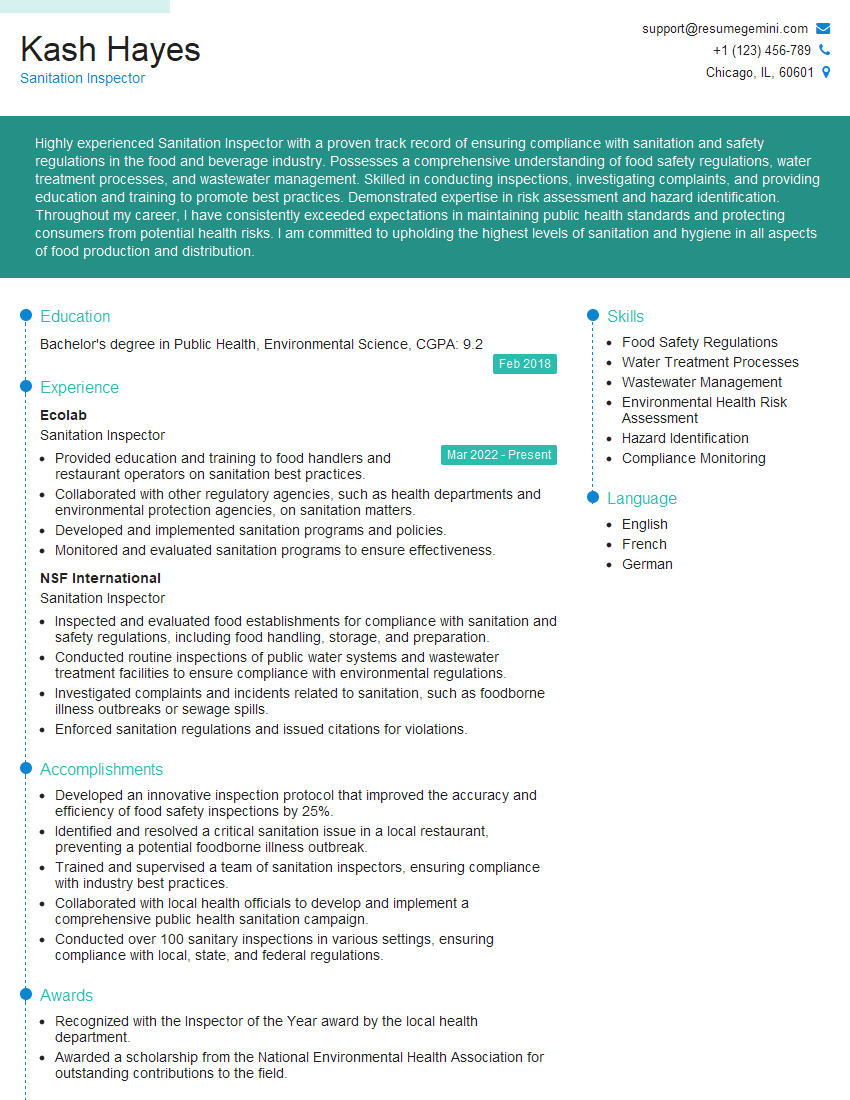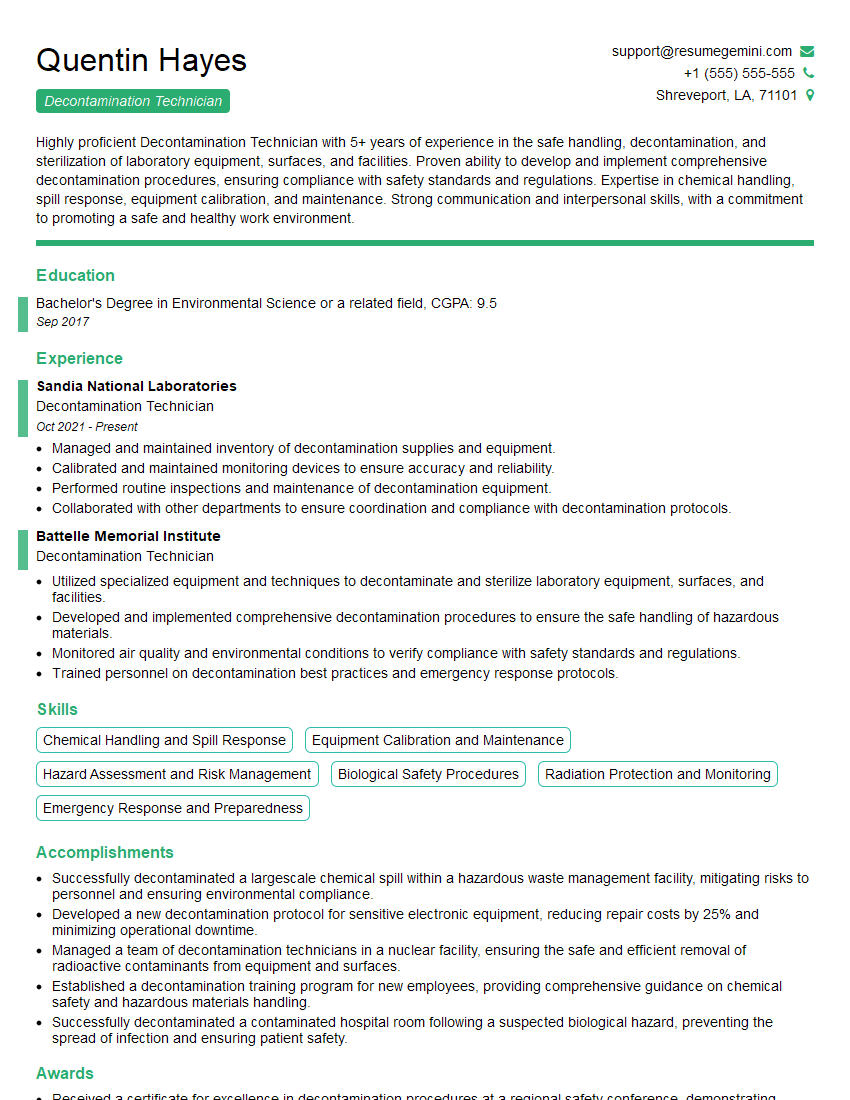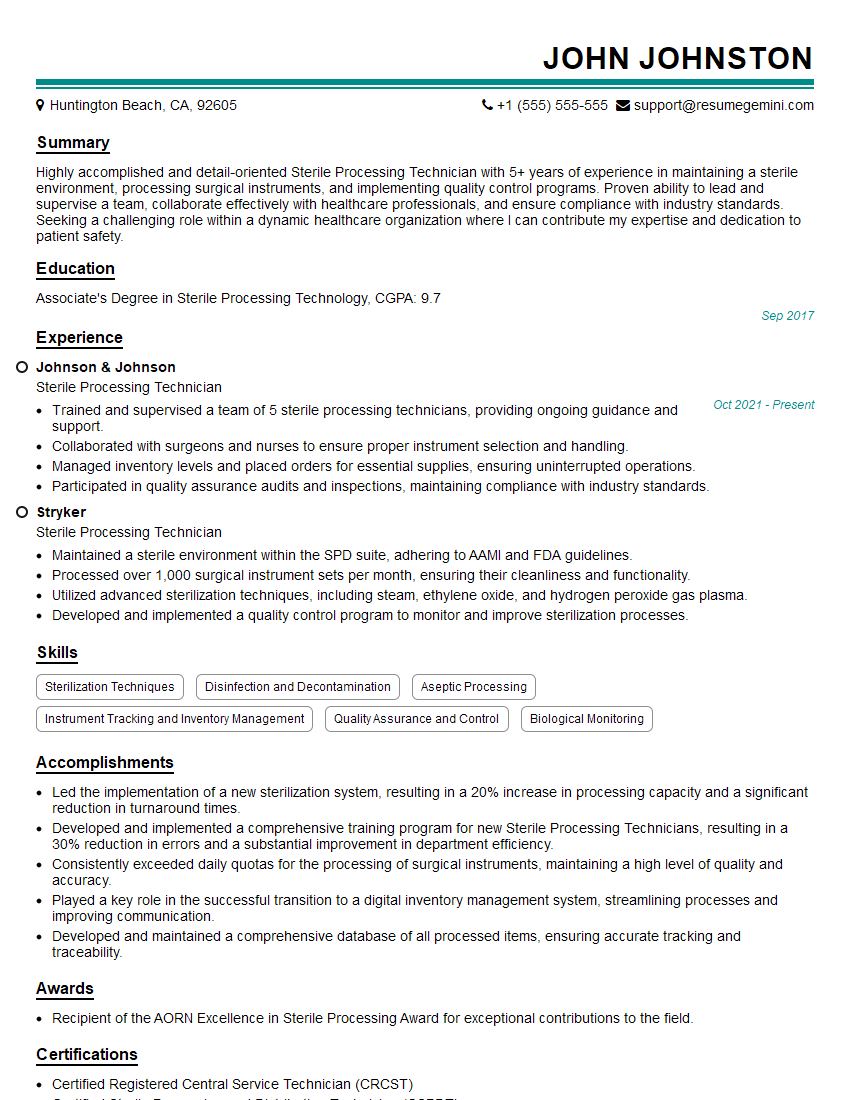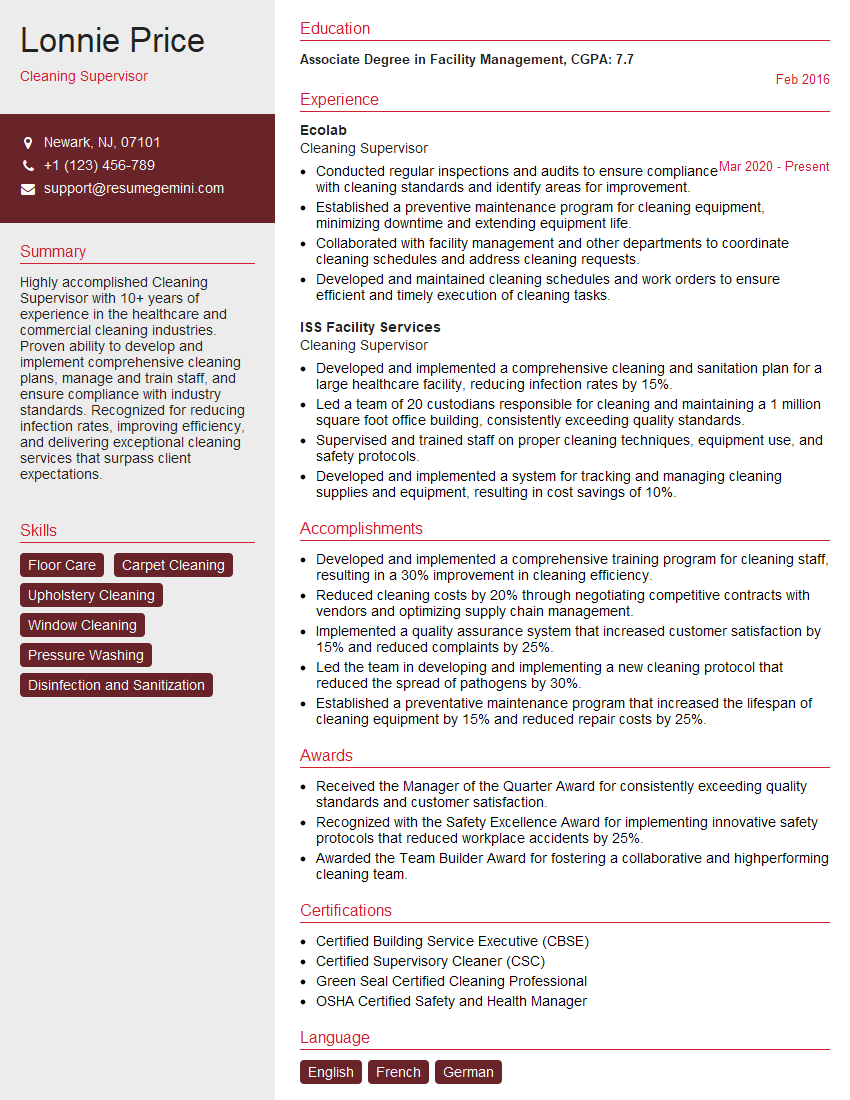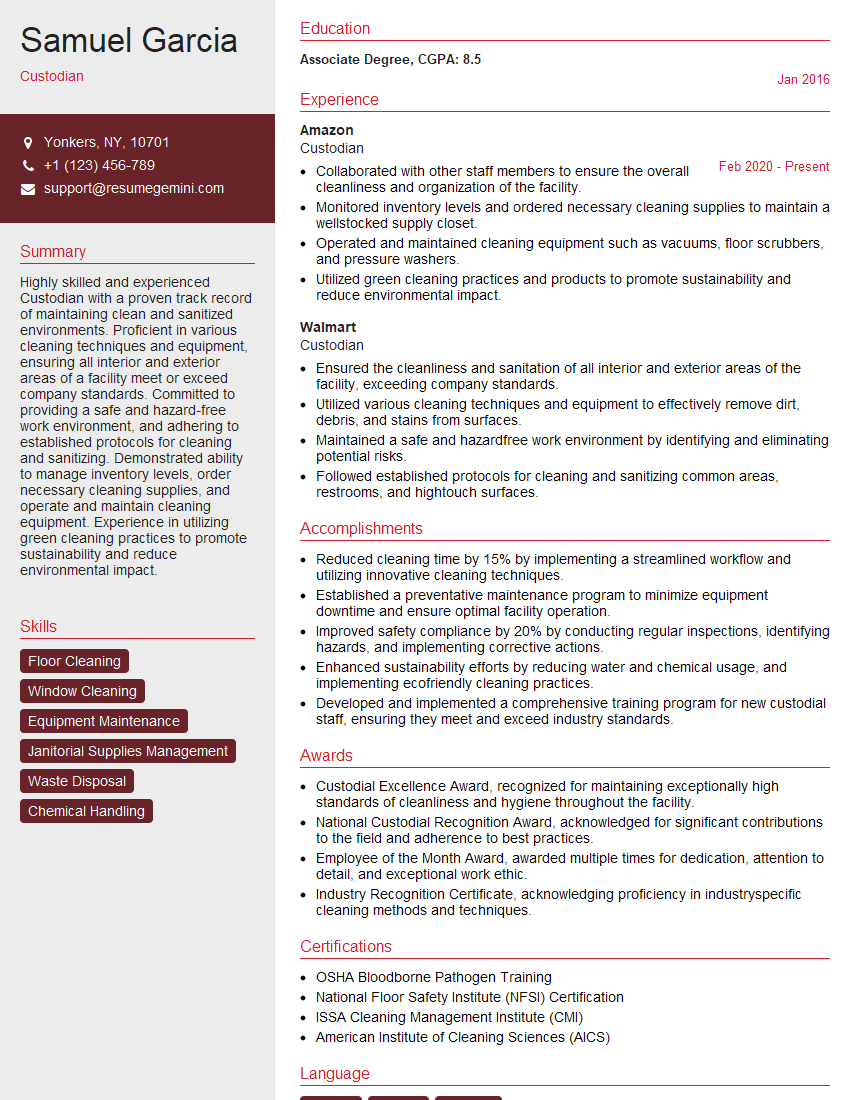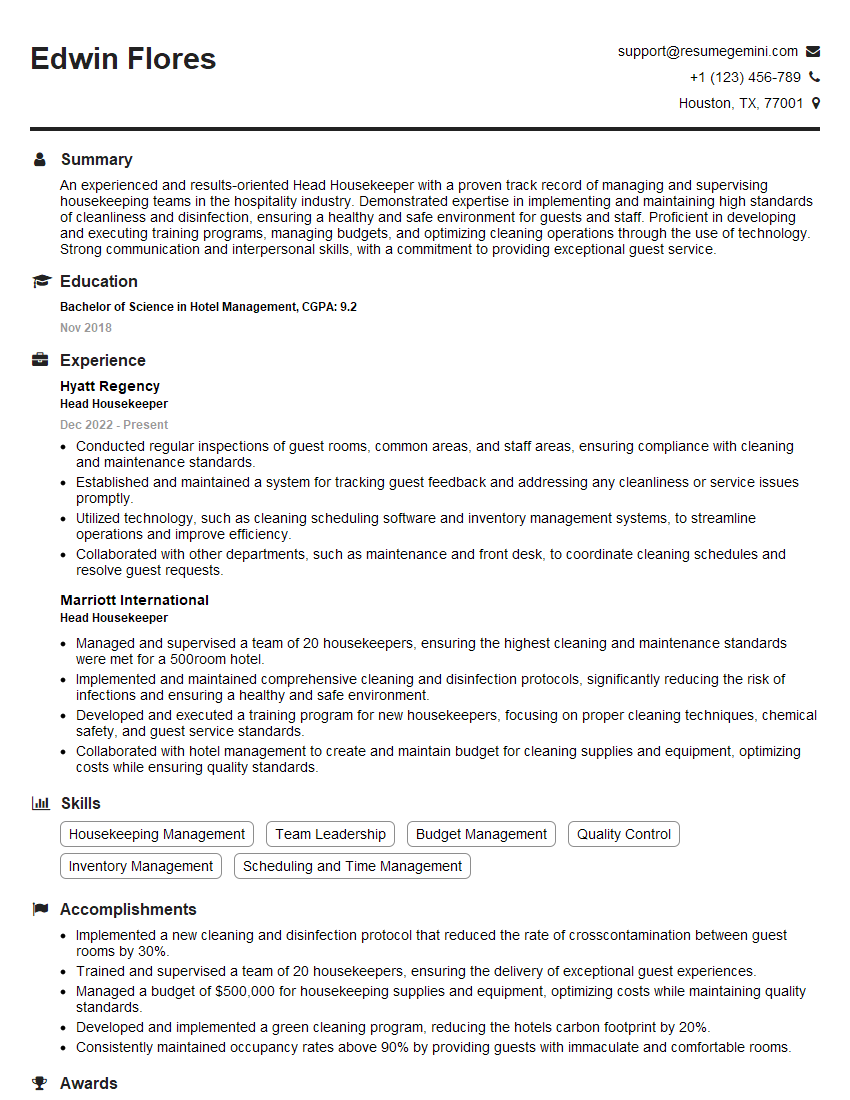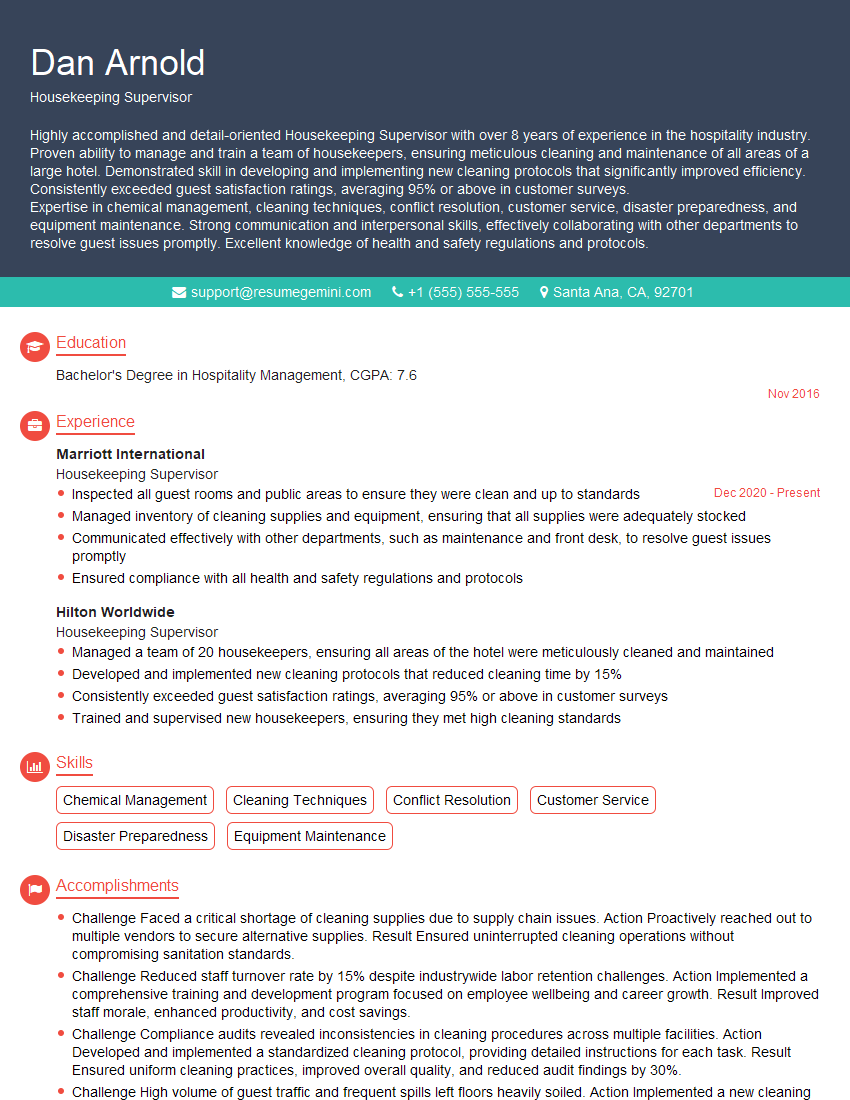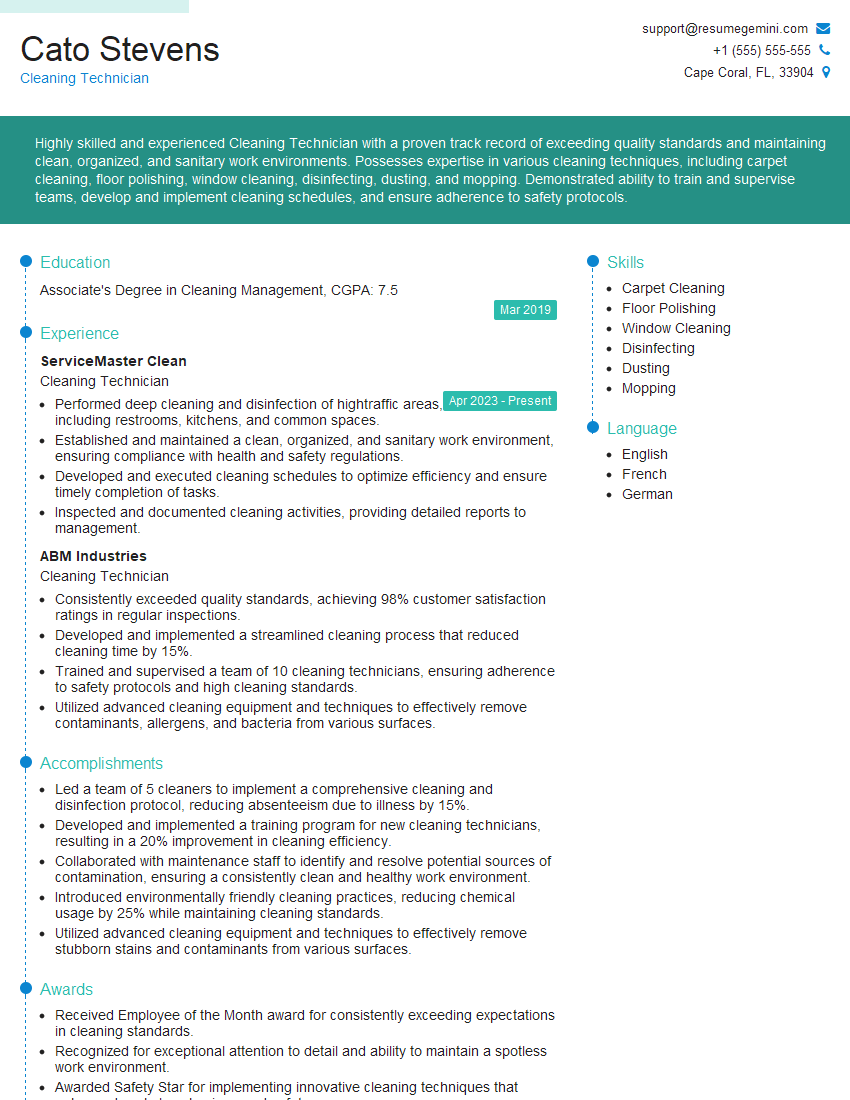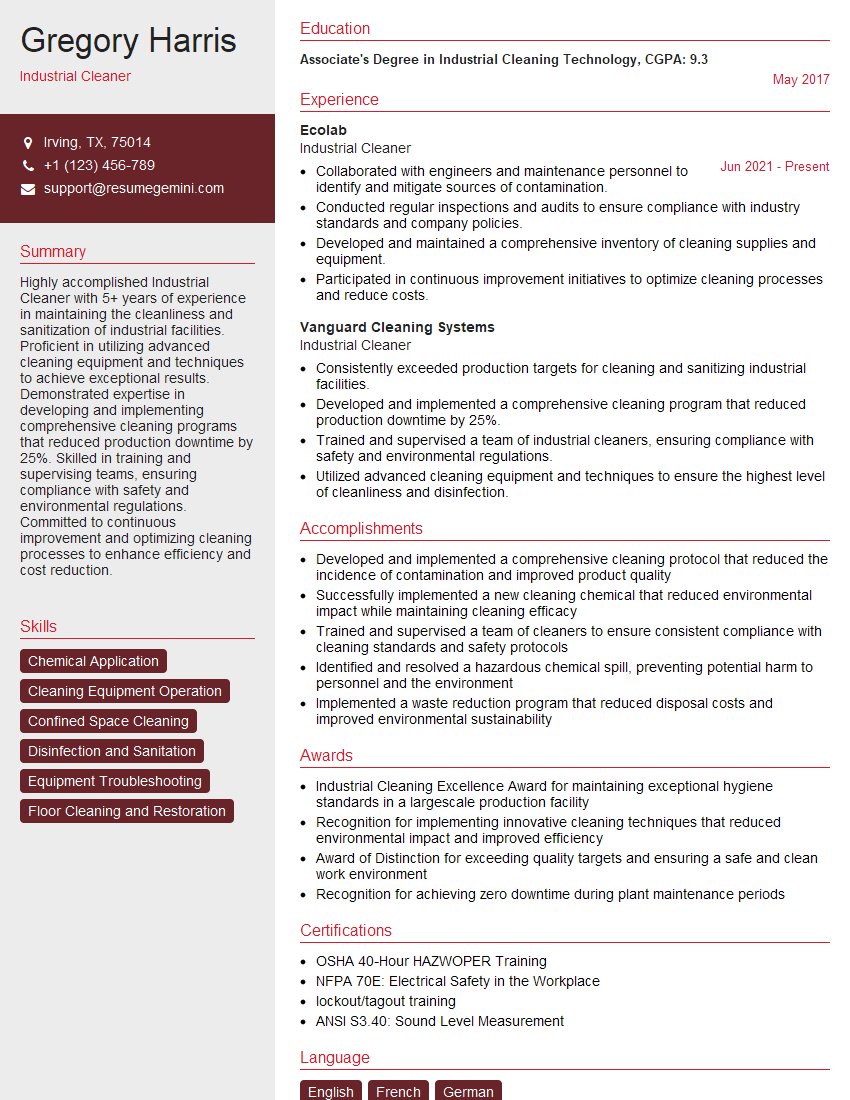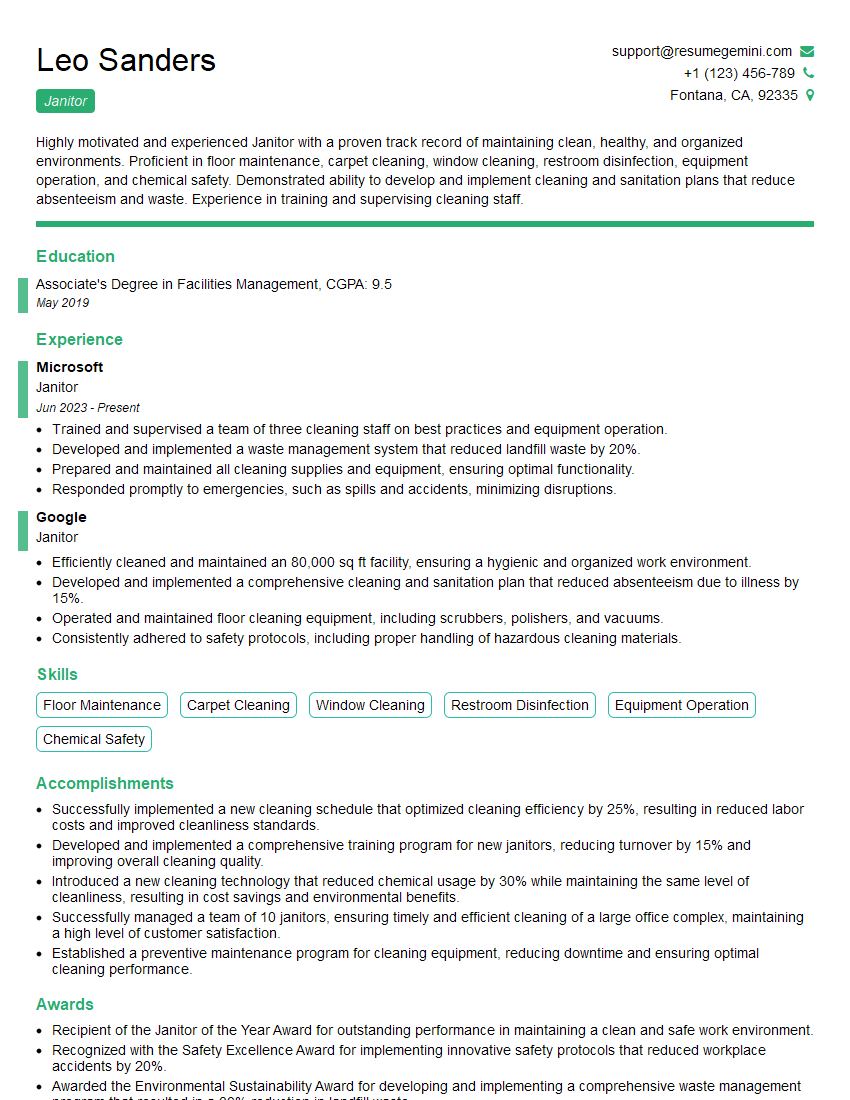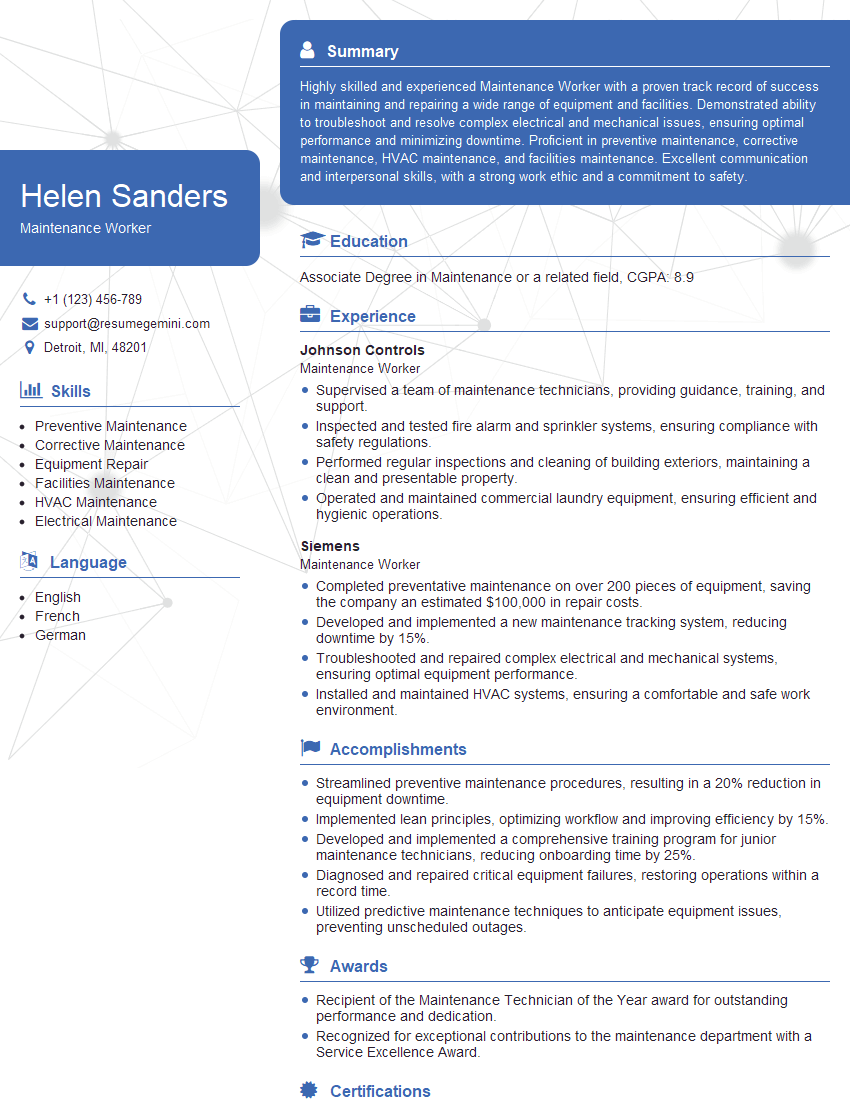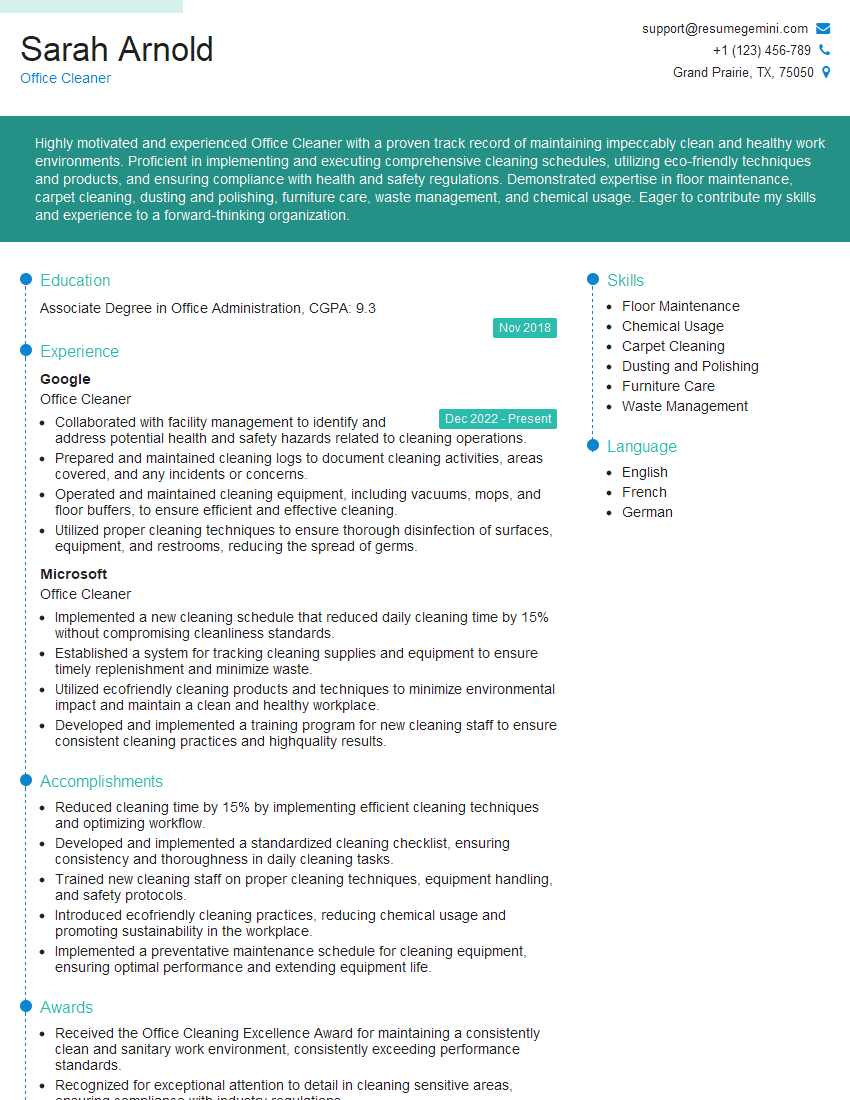Cracking a skill-specific interview, like one for Use appropriate cleaning techniques and materials to clean fixtures and equipment, requires understanding the nuances of the role. In this blog, we present the questions you’re most likely to encounter, along with insights into how to answer them effectively. Let’s ensure you’re ready to make a strong impression.
Questions Asked in Use appropriate cleaning techniques and materials to clean fixtures and equipment Interview
Q 1. What are the different types of disinfectants and when would you use each?
Disinfectants are crucial for eliminating harmful microorganisms. The choice of disinfectant depends heavily on the type of surface and the specific pathogens you’re targeting. Common types include:
- Quaternary Ammonium Compounds (Quats): These are broad-spectrum disinfectants effective against a wide range of bacteria and viruses. They’re commonly used for general cleaning in many settings, like hospitals and food service establishments. Think of them as your all-around workhorses. For example, a quat-based cleaner might be used to disinfect a hospital room after a patient’s discharge.
- Chlorine Bleach Solutions: Highly effective against a broad range of microorganisms, including bacteria, viruses, and fungi. However, bleach is corrosive, and its concentration must be carefully controlled to prevent damage to surfaces. I would use a diluted bleach solution (following manufacturer’s instructions carefully!) for disinfecting surfaces contaminated with particularly nasty pathogens, like Clostridium difficile spores.
- Phenolics: These are powerful disinfectants often used in healthcare settings, especially for areas needing high-level disinfection. They are effective against a broad spectrum of microorganisms, including some resistant bacteria. They’re good for surfaces that require a robust disinfectant, but remember, they often have a stronger smell.
- Alcohol-based disinfectants (Isopropyl alcohol or Ethanol): These are quick-acting and effective against many bacteria and viruses but are less effective against spores. They’re ideal for quickly disinfecting small areas or equipment that can tolerate alcohol, like medical equipment. Think of cleaning a stethoscope between patients.
The selection process always prioritizes safety and efficacy. I always refer to the manufacturer’s instructions for dilution rates and contact times to ensure proper disinfection.
Q 2. Explain the proper procedure for cleaning and sanitizing a restroom.
Cleaning and sanitizing a restroom requires a methodical approach to ensure hygiene and safety. My procedure typically follows these steps:
- Preparation: Put on appropriate Personal Protective Equipment (PPE), including gloves and eye protection. Gather all necessary cleaning supplies – disinfectant, cleaning solution, paper towels, toilet bowl cleaner, trash bags, etc.
- Cleaning: Start by removing all trash and disposing of it properly. Then, clean all surfaces, including sinks, countertops, toilets, and floors, using a suitable cleaning solution. I always work from the top down to prevent recontamination.
- Sanitizing: After cleaning, apply a suitable disinfectant to all surfaces, paying close attention to high-touch areas like door handles, faucets, and toilet flush handles. Allow the disinfectant to remain on the surfaces for the contact time specified by the manufacturer.
- Toilet Cleaning: Use a toilet bowl cleaner according to its instructions to clean and disinfect the toilet bowl and under the rim. I often use a toilet brush designed for disposable cleaning pads.
- Floor Cleaning: Clean the floor thoroughly using an appropriate cleaning solution and mop. I ensure to change the mop water frequently to prevent spreading dirt.
- Final Steps: Replenish soap, paper towels, and hand sanitizer. Dispose of all cleaning materials responsibly. Remove PPE and wash hands thoroughly.
The key is to follow a consistent procedure to ensure all areas are cleaned and disinfected to the highest standards.
Q 3. How do you handle spills of hazardous materials?
Handling hazardous material spills requires immediate and careful action. The priority is always safety. My response involves these key steps:
- Assess the situation: Determine the nature of the spilled substance. Is it corrosive, flammable, toxic, or biohazardous? This dictates the appropriate response and PPE.
- Ensure safety: Evacuate the area if necessary and restrict access to prevent further exposure. Wear appropriate PPE, including gloves, eye protection, and possibly a respirator depending on the material.
- Contain the spill: Use absorbent materials like spill pads or kitty litter to absorb the spill. Prevent it from spreading further. If the spill is large, consider using containment booms.
- Clean up the spill: Carefully collect the absorbent materials and dispose of them according to the regulations governing hazardous waste disposal. Thoroughly clean the affected area using the appropriate cleaning agent recommended for that specific hazardous material. Refer to the Safety Data Sheet (SDS) for guidance.
- Document the incident: Record details of the spill, including the type of material, quantity, location, time, and the cleanup procedures followed. Report the incident to the appropriate authorities.
Each type of hazardous material has specific handling requirements, always check the SDS for detailed instructions.
Q 4. What safety precautions do you take when using cleaning chemicals?
Safety is paramount when using cleaning chemicals. My precautions include:
- Always read and follow the label instructions: This includes understanding dilution rates, contact times, and safety precautions.
- Wear appropriate Personal Protective Equipment (PPE): This typically includes gloves, eye protection, and sometimes a respirator, depending on the chemical. I always choose the appropriate PPE based on the SDS information.
- Work in a well-ventilated area: Open windows and doors to ensure proper ventilation, or utilize proper ventilation systems if available. Avoid mixing different chemicals unless specifically instructed to do so by the manufacturer.
- Handle chemicals carefully: Avoid splashing or spilling chemicals onto skin or clothing. Store chemicals properly in their designated containers and keep them out of reach of children and unauthorized personnel.
- Dispose of chemicals properly: Never pour cleaning chemicals down the drain unless specifically allowed. Follow all local, state and federal regulations when disposing of these materials.
Remember, prevention is key. A minor oversight can have major consequences.
Q 5. Describe your experience with various cleaning equipment (e.g., floor buffers, vacuum cleaners).
I have extensive experience with a range of cleaning equipment. My experience includes:
- Floor buffers: I’m proficient in operating both rotary and orbital floor buffers, selecting the appropriate pad for different floor types (e.g., stripping and waxing, scrubbing, polishing). I understand the importance of proper speed and technique to achieve effective cleaning without damaging the floor.
- Vacuum cleaners: I’m familiar with various types of vacuum cleaners, including upright, canister, and backpack vacuums. I can select the appropriate vacuum for different cleaning tasks, such as carpet cleaning, hard floor cleaning, and upholstery cleaning. I also know how to maintain and troubleshoot common issues.
- Other equipment: I’m experienced with auto-scrubbers, pressure washers, carpet extractors, and other specialized equipment depending on the setting and task at hand.
I always prioritize safe operation and proper maintenance of all equipment to ensure both effective cleaning and safety.
Q 6. How do you determine the appropriate cleaning solution for different surfaces?
Selecting the right cleaning solution is crucial to avoid damaging surfaces. I consider several factors:
- Surface type: Different materials require different cleaning solutions. For instance, harsh chemicals might damage delicate surfaces like marble or granite, while wood may need specialized cleaning products to maintain its finish. I avoid using abrasive cleaners on delicate surfaces.
- Soil type: The type of dirt or grime present will influence the cleaning solution. Grease and oil require degreasers, while other soils might respond to all-purpose cleaners. Understanding the kind of soil present is important.
- Manufacturer recommendations: Always check manufacturer’s recommendations for cleaning specific surfaces. Their instructions are designed to safeguard the material and guarantee effective cleaning.
I always err on the side of caution. When in doubt, I perform a small test on an inconspicuous area to ensure the cleaning solution doesn’t damage the surface. A small amount of product on an area hidden from sight before applying it over the entire surface is the best approach.
Q 7. What is your experience with infection control procedures?
Infection control is a critical aspect of my cleaning practice. My experience includes:
- Understanding infection control protocols: I’m familiar with standard precautions, transmission-based precautions (contact, droplet, airborne), and other infection control guidelines. My knowledge extends to local, state, and federal regulations.
- Proper disinfection techniques: I’m proficient in using various disinfectants and following proper disinfection procedures to eliminate harmful microorganisms. I follow all manufacturers’ recommendations concerning contact times and appropriate surface preparation.
- Handling biohazardous materials: I’m trained in handling biohazardous waste safely and following appropriate disposal protocols. This includes proper handling, labeling, and containment of potentially infectious materials.
- PPE usage: I’m always meticulous in using appropriate PPE to protect myself and prevent the spread of infection. This includes knowing which PPE is appropriate for which situation.
My goal is to create a safe and sanitary environment by consistently applying infection control practices.
Q 8. How do you maintain a consistent cleaning schedule?
Maintaining a consistent cleaning schedule is crucial for hygiene and efficiency. It involves a blend of planning, task prioritization, and adherence to a timetable. I typically begin by creating a detailed schedule, breaking down tasks by area and frequency. For example, restrooms might require cleaning multiple times a day, while general office areas might need cleaning once a day. This schedule is often documented, perhaps in a digital calendar or printed checklist, ensuring everyone on the cleaning team is aware of their responsibilities and the schedule’s specifics.
I also factor in high-traffic areas and peak usage times. For instance, in a restaurant, the dining area would be cleaned more frequently during lunch and dinner rushes. Regular review and adjustments are key – I’d assess the schedule’s effectiveness, noting areas requiring more attention or shifts in traffic patterns that necessitate changes. This iterative process keeps the schedule dynamic and responsive to real-world needs.
Q 9. How do you ensure the proper disposal of cleaning waste?
Proper disposal of cleaning waste is paramount for environmental safety and compliance. My approach involves strict adherence to local regulations and company protocols. This typically involves segregating waste into different categories – for example, separating hazardous waste (like certain cleaning chemicals) from regular trash. Hazardous waste requires special containers and often necessitates contacting a licensed waste disposal company for pickup. I always ensure proper labeling of containers to avoid accidental mixing or misuse.
For regular trash, appropriate disposal bins are utilized, and they’re emptied regularly to prevent overflows and maintain a clean environment. The cleaning schedule often includes specific tasks for waste disposal to ensure consistent and timely removal. I make sure to always consult the Safety Data Sheets (SDS) for each cleaning product to understand the specific disposal requirements.
Q 10. Describe your experience with using personal protective equipment (PPE).
Personal Protective Equipment (PPE) is non-negotiable in my cleaning practices. I have extensive experience using a variety of PPE, including gloves (nitrile and latex, chosen based on the cleaning agent used), safety glasses or goggles to protect my eyes from splashes, and respirators when dealing with potentially harmful dust or fumes. For example, when cleaning areas with strong cleaning chemicals, I always use appropriate gloves and eye protection. If I’m handling potentially moldy areas, I’ll wear an N95 respirator to avoid inhaling spores.
I’m familiar with proper donning and doffing procedures, emphasizing safe removal of PPE to prevent contamination. Before using any PPE, I always check its condition to ensure it is clean, undamaged, and provides adequate protection. Regular training on PPE usage is essential, and I actively participate to ensure my techniques are up-to-date and safe.
Q 11. How do you address customer complaints regarding cleaning?
Addressing customer complaints regarding cleaning requires a professional and empathetic approach. My first step is always to listen attentively to the customer’s concerns, acknowledging their frustration and validating their feedback. I then actively take notes to understand the specifics of the issue. Once I understand the complaint, I either address the issue immediately or, if it requires further investigation, establish a timeline for a resolution.
For instance, if a customer complains about a dirty restroom, I immediately inspect the area. If the complaint is valid, I apologize, re-clean the area thoroughly, and possibly implement changes to prevent similar issues. Following this, I would follow up with the customer to ensure they are satisfied with the resolution. Open communication and a commitment to resolving the problem are key to maintaining positive customer relations.
Q 12. Explain your understanding of OSHA regulations related to cleaning and sanitation.
My understanding of OSHA regulations regarding cleaning and sanitation is thorough. OSHA standards emphasize worker safety and health, and I am familiar with regulations pertaining to the safe handling of chemicals, proper ventilation, and the use of PPE. I’m aware of the importance of Hazard Communication Standard (HazCom), ensuring I can correctly read and interpret Safety Data Sheets (SDS) for all cleaning products. This knowledge guides my selection of cleaning agents and methods, prioritizing safety protocols.
Furthermore, I’m familiar with Bloodborne Pathogens Standard, understanding proper procedures for cleaning up bodily fluids to prevent infection. I am also aware of regulations regarding ergonomic practices to prevent work-related musculoskeletal disorders (MSDs) from repetitive tasks. Regular training and updates on OSHA guidelines are part of my professional development to maintain compliance and ensure a safe work environment.
Q 13. How do you prioritize cleaning tasks in a high-traffic area?
Prioritizing cleaning tasks in a high-traffic area requires a strategic approach. My strategy involves a combination of frequency, impact, and urgency. I start by identifying high-impact areas – those with the most visible dirt or those posing the greatest safety hazard. For example, in a shopping mall, entranceways and restrooms would be prioritized over less-trafficked areas.
Next, I consider task frequency. High-traffic areas often require more frequent cleaning (e.g., wiping down surfaces every hour). Lastly, I factor in urgency. Spills or immediate hazards must be addressed immediately, regardless of their location. This multi-faceted approach ensures that the most critical cleaning tasks are always addressed first, maintaining a clean and safe environment for everyone.
Q 14. What is your experience with green cleaning products and techniques?
I have significant experience with green cleaning products and techniques, emphasizing environmentally friendly and sustainable practices. This includes using biodegradable cleaning agents, microfiber cloths (reducing water and chemical usage), and implementing practices that conserve water. For example, I use enzymatic cleaners for removing grease and stains, reducing the need for harsh chemicals.
I’m familiar with various green cleaning certifications and choose products that meet these standards. I also utilize practices such as proper ventilation to reduce the need for strong chemicals and focusing on preventative cleaning – regular dusting and wiping to prevent the build-up of dirt, thus reducing the need for aggressive cleaning later. In addition, I implement strategies to minimize waste, such as using reusable cleaning cloths and properly recycling waste.
Q 15. How do you prevent the spread of germs and bacteria during cleaning?
Preventing the spread of germs and bacteria during cleaning is paramount. It involves a multi-pronged approach focusing on proper techniques and the use of effective disinfectants.
- Clean before you disinfect: Always start by removing visible dirt and debris. This reduces the load of germs and allows disinfectants to work more effectively. Think of it like washing your hands before applying hand sanitizer – the sanitizer works better on clean skin.
- Use appropriate disinfectants: Different disinfectants target different types of germs. Always follow the manufacturer’s instructions for dilution and contact time. For example, a solution of bleach and water is effective against many common bacteria and viruses, but the concentration must be correct and the surface must remain wet for the specified time.
- Work methodically: Clean from top to bottom and from cleanest to dirtiest areas to avoid re-contaminating already cleaned surfaces. Imagine cleaning a bathroom: start with the ceiling, then walls, then fixtures, and finally the floor.
- Change cleaning cloths frequently: Contaminated cloths spread germs. Use clean cloths for each task and dispose of them properly after use. Color-coding cloths for different areas (e.g., red for toilets, blue for sinks) can also help avoid cross-contamination.
- Proper hand hygiene: This is crucial. Wash your hands thoroughly with soap and water before and after cleaning, and especially after handling contaminated materials. Hand sanitizer can be used if soap and water aren’t readily available.
By following these steps, we can significantly minimize the spread of harmful microorganisms and create a healthier environment.
Career Expert Tips:
- Ace those interviews! Prepare effectively by reviewing the Top 50 Most Common Interview Questions on ResumeGemini.
- Navigate your job search with confidence! Explore a wide range of Career Tips on ResumeGemini. Learn about common challenges and recommendations to overcome them.
- Craft the perfect resume! Master the Art of Resume Writing with ResumeGemini’s guide. Showcase your unique qualifications and achievements effectively.
- Don’t miss out on holiday savings! Build your dream resume with ResumeGemini’s ATS optimized templates.
Q 16. How do you maintain the cleanliness of cleaning equipment?
Maintaining clean cleaning equipment is as important as cleaning the environment itself. Dirty equipment can spread germs and compromise the effectiveness of cleaning.
- Rinse and dry thoroughly after each use: This prevents the build-up of residue and the growth of bacteria and mold. Imagine leaving a sponge wet and soapy – it would become a breeding ground for microbes.
- Regularly disinfect equipment: Use a suitable disinfectant according to the manufacturer’s instructions. For example, mops and buckets should be disinfected after each use, especially in high-traffic areas or healthcare settings.
- Store equipment properly: Store equipment in a clean, dry place to prevent contamination and damage. This could involve dedicated storage containers or designated areas.
- Replace worn-out equipment: Mops, sponges, and other cleaning materials wear out and become less effective over time. Replace them regularly to maintain hygiene and cleaning efficiency. A frayed mop head, for instance, won’t clean effectively and could harbor germs.
- Regular maintenance: For more complex equipment, like floor cleaning machines, follow the manufacturer’s maintenance schedule, including regular cleaning and replacement of parts.
By diligently maintaining our equipment, we can ensure consistently high standards of cleanliness and hygiene.
Q 17. How do you ensure the safety of yourself and others while cleaning?
Safety is paramount in any cleaning operation. This involves protecting both oneself and others from injury and exposure to hazardous materials.
- Use appropriate Personal Protective Equipment (PPE): Gloves, eye protection, and respirators should be worn when handling cleaning chemicals or potentially hazardous materials. This protects against chemical splashes, inhalation of fumes, and skin contact. Gloves are particularly important as they prevent the spread of germs and protect hands from harsh chemicals.
- Proper chemical handling: Always follow the manufacturer’s instructions when using cleaning chemicals. This includes wearing appropriate PPE, diluting chemicals correctly, and avoiding mixing different chemicals, as this can create dangerous reactions.
- Safe use of equipment: Operate all cleaning equipment according to the manufacturer’s instructions. This includes understanding safety features and following proper procedures to prevent accidents. Using a wet floor sign when mopping, for example, prevents slips and falls.
- Proper disposal of waste: Dispose of cleaning materials and waste appropriately according to local regulations and safety guidelines. Improper disposal can contaminate the environment and pose health risks.
- Awareness of surroundings: Be aware of your surroundings and potential hazards while cleaning. Clear walkways, be mindful of wet floors, and use caution in confined spaces.
Prioritizing safety ensures a healthy and productive work environment for everyone.
Q 18. What is your experience with specialized cleaning tasks (e.g., carpet cleaning, window washing)?
I have extensive experience in specialized cleaning tasks, including carpet cleaning, window washing, and upholstery cleaning.
- Carpet Cleaning: I’m proficient in using both hot water extraction (steam cleaning) and dry cleaning methods, selecting the most appropriate technique based on the carpet type and the level of soiling. I understand the importance of pre-treating stains and using appropriate cleaning solutions to avoid damage to the carpet fibers.
- Window Washing: My window washing technique involves using high-quality squeegees and cleaning solutions to achieve streak-free results. I am comfortable working at heights, using appropriate safety equipment, and employing efficient techniques to minimize disruption.
- Upholstery Cleaning: I have experience cleaning various upholstery fabrics, understanding the importance of selecting appropriate cleaning solutions and techniques to avoid damage or discoloration. Pre-testing cleaning solutions in an inconspicuous area is crucial before cleaning the entire piece.
My experience in these areas ensures high-quality results while minimizing damage and disruption.
Q 19. What is your process for evaluating the effectiveness of cleaning procedures?
Evaluating the effectiveness of cleaning procedures involves a multi-faceted approach.
- Visual Inspection: A thorough visual inspection after cleaning is the first step. Are surfaces visibly clean and free from dirt, grime, and stains? This is a simple but essential check for obvious cleanliness.
- Microbial Testing: In some settings, such as healthcare or food processing, microbial testing may be necessary to quantitatively assess the reduction in bacterial load after cleaning. This involves collecting samples before and after cleaning and analyzing them in a laboratory setting.
- Feedback and Observation: Gathering feedback from users of the space is valuable. Are they satisfied with the cleanliness? Are there recurring areas of concern? Observations over time can also help identify areas that require more frequent or specialized cleaning.
- Documentation and Tracking: Maintaining detailed records of cleaning procedures, chemicals used, and any issues encountered allows for consistent evaluation and improvement over time. This could involve checklists, logs, or software solutions.
By using a combination of these methods, we can continually refine and improve our cleaning procedures to ensure optimal effectiveness and hygiene.
Q 20. How would you handle a situation where a cleaning chemical is misused?
Misuse of cleaning chemicals can have serious consequences, ranging from minor skin irritation to severe health problems. My response would be swift and focused on safety and remediation.
- Immediate Action: My first priority would be to ensure the safety of myself and others. This might involve evacuating the area if necessary, providing first aid if someone has been exposed, and ensuring adequate ventilation.
- Assess the Situation: I would carefully assess the nature of the misuse and the extent of any exposure or damage. What chemical was misused? How much was involved? Were there any injuries or property damage?
- Follow Safety Protocols: I would carefully follow all relevant safety protocols, referring to the Safety Data Sheet (SDS) for the specific chemical involved. The SDS provides crucial information on handling spills, first aid, and disposal procedures.
- Remediation: I would take the necessary steps to clean up the spill and mitigate any damage, following the instructions on the SDS. This may involve using specific neutralizing agents or absorbent materials.
- Reporting and Documentation: I would document the incident thoroughly, including the details of the misuse, any resulting injuries or damage, and the actions taken. This information should be reported to the appropriate supervisor or authority.
Proper training and adherence to safety protocols are crucial to preventing chemical misuse incidents and responding effectively when they occur.
Q 21. What training have you received in cleaning and sanitation?
Throughout my career, I’ve received comprehensive training in cleaning and sanitation.
- Formal Training: I have completed [Mention specific certifications or training courses, e.g., a nationally recognized cleaning certification program or specific training in bloodborne pathogen safety]. This training covered a wide range of topics, including safe chemical handling, proper cleaning techniques, infection control, and equipment maintenance.
- On-the-Job Training: My extensive experience has provided invaluable on-the-job training, allowing me to refine my skills and adapt to various cleaning challenges. I’ve worked in diverse settings, including [Mention examples of different work environments, e.g., hospitals, offices, and schools], exposing me to a wide range of cleaning needs and techniques.
- Continuing Education: I actively participate in continuing education opportunities, staying current on best practices and emerging technologies in the cleaning industry. This includes attending workshops, reading industry publications, and participating in professional development programs.
My commitment to ongoing learning and development ensures that I maintain the highest standards of knowledge and skill in cleaning and sanitation.
Q 22. How do you adapt your cleaning techniques to different environments?
Adapting cleaning techniques hinges on understanding the unique challenges each environment presents. For instance, a hospital requires stringent sterilization protocols and specialized disinfectants to combat healthcare-associated infections, unlike a retail space, which may prioritize speed and efficiency with less emphasis on sterility. My approach involves a thorough assessment of the space – identifying surfaces, materials (e.g., marble, wood, stainless steel), potential contaminants, and traffic levels.
- Healthcare: I utilize EPA-registered hospital-grade disinfectants, following strict protocols for contact time and personal protective equipment (PPE). I’m meticulous about preventing cross-contamination, using color-coded cleaning cloths and separate buckets for soiled and clean water.
- Retail: Here, speed and minimal disruption to customers are paramount. I’d employ efficient cleaning methods like microfiber mops and auto-scrubbers, prioritizing high-traffic areas and focusing on visible dirt and grime. I would also prioritize eco-friendly products where possible.
- Industrial: Industrial settings often involve heavy machinery and hazardous materials, demanding specialized training and safety precautions. I prioritize safe handling procedures, utilize industrial-strength cleaning agents, and follow specific safety protocols provided by the workplace.
Essentially, my flexibility allows me to tailor my approach, choosing appropriate cleaning agents, tools, and safety measures for optimal results and a safe working environment, regardless of the setting.
Q 23. Describe your experience with inventory management of cleaning supplies.
Effective inventory management of cleaning supplies is crucial for maintaining efficiency and cost-effectiveness. In previous roles, I’ve used a combination of methods to ensure optimal stock levels. This involves regular stock checks, maintaining a detailed inventory list (both physical and digital), and implementing a reordering system based on consumption rates.
- Regular Stock Checks: I conduct weekly visual checks of all cleaning supplies, noting stock levels and identifying any nearing depletion. This provides a proactive approach to avoid running out of crucial materials.
- Detailed Inventory List: This list includes all cleaning agents, tools, and equipment, along with their quantities, usage rates, and storage location. I use a spreadsheet or dedicated inventory management software to track this information efficiently.
- Reordering System: Based on consumption patterns, I establish reorder points for each item. This prevents stockouts while avoiding unnecessary overstocking, saving both time and money.
- Waste Reduction Strategies: I actively seek to minimize waste by using appropriate quantities of cleaning solutions and properly disposing of used materials according to environmental regulations.
By implementing these strategies, I have consistently ensured that sufficient supplies are available to maintain a consistently clean and hygienic environment, while minimizing unnecessary expenses.
Q 24. How do you track and document cleaning activities?
Tracking and documenting cleaning activities is paramount for ensuring accountability, maintaining hygiene standards, and demonstrating compliance with regulations. I utilize a combination of methods to maintain accurate records.
- Cleaning Schedules: I create detailed cleaning schedules outlining specific tasks, frequency, and assigned personnel. This ensures consistency and covers all areas.
- Checklists: For each cleaning task, I use checklists to confirm completion of all steps. This ensures thoroughness and minimizes missed areas.
- Digital Logs: I use digital logs (spreadsheets, dedicated software) to record the date, time, area cleaned, cleaning agents used, and any notable issues or maintenance needs. This provides detailed and easily accessible records.
- Photographs: In some cases, especially post-cleaning inspections or after major cleaning events, I take photographs to document the cleanliness of the area.
These methods ensure a transparent and auditable record of all cleaning activities, useful for quality control and regulatory compliance. For example, in a food service environment, detailed cleaning logs are essential for health inspections.
Q 25. What are your strengths and weaknesses regarding cleaning tasks?
My strengths lie in my attention to detail, my organizational skills, and my ability to adapt to different cleaning challenges. I pride myself on my thoroughness and efficiency, consistently delivering high-quality cleaning results. I’m also a quick learner and always eager to adopt new techniques and technologies to improve my workflow.
One area I’m actively working on is delegation. While I’m capable of handling large workloads independently, I am learning to effectively delegate tasks within a team to optimize efficiency and empower others. This involves clear communication and effective training.
Q 26. What are your salary expectations?
My salary expectations are commensurate with my experience and the requirements of this position. I’m confident that my skills and dedication will be a valuable asset to your team, and I’m open to discussing a competitive compensation package that reflects my contributions.
Q 27. Are you comfortable working independently and as part of a team?
Yes, I’m comfortable working both independently and as part of a team. I’m self-motivated and able to manage my time effectively to complete tasks independently, while also possessing strong teamwork skills. I believe in collaborative efforts and value the contributions of others. I am adept at communicating effectively, sharing information, and working collaboratively to achieve common goals. For example, in a previous role, I successfully led a team in deep cleaning a large facility, delegating tasks and ensuring efficient coordination to meet a tight deadline.
Q 28. Why are you interested in this cleaning position?
I’m interested in this cleaning position because I’m passionate about creating clean and healthy environments. I find immense satisfaction in transforming spaces and contributing to a positive work experience for others. The opportunity to utilize my skills and experience in a challenging and rewarding setting strongly appeals to me. Furthermore, I’m excited about the chance to contribute to [Company Name]’s commitment to [mention company values or mission related to cleanliness, if known].
Key Topics to Learn for “Use Appropriate Cleaning Techniques and Materials to Clean Fixtures and Equipment” Interview
- Understanding Cleaning Agents: Knowing the properties of different cleaning solutions (e.g., disinfectants, detergents, degreasers) and their appropriate uses on various surfaces (e.g., stainless steel, glass, porcelain).
- Safe Handling and Application: Mastering techniques for safe and effective application, including dilution ratios, proper mixing, and avoiding cross-contamination. Understanding the importance of personal protective equipment (PPE).
- Cleaning Methods and Procedures: Familiarizing yourself with various cleaning methods (e.g., wiping, scrubbing, rinsing) and understanding the importance of following established procedures to ensure thorough and hygienic cleaning.
- Equipment Maintenance and Care: Learning how to properly clean and maintain cleaning equipment (e.g., mops, buckets, spray bottles) to prolong their lifespan and ensure hygiene.
- Hygiene and Sanitation Principles: Demonstrating knowledge of basic hygiene and sanitation principles, including preventing the spread of bacteria and viruses.
- Identifying and Addressing Cleaning Challenges: Understanding how to identify and effectively address common cleaning challenges, such as stubborn stains, grease buildup, or limescale.
- Waste Disposal and Environmental Considerations: Knowing proper procedures for handling and disposing of cleaning chemicals and waste responsibly and sustainably.
Next Steps
Mastering appropriate cleaning techniques and materials is crucial for career advancement in many fields. A strong understanding of hygiene and sanitation demonstrates responsibility and attention to detail, qualities highly valued by employers. To make your application stand out, create an ATS-friendly resume that highlights your skills and experience. ResumeGemini is a trusted resource to help you build a professional and effective resume that showcases your abilities. Examples of resumes tailored to this skill set are available to help you get started.
Explore more articles
Users Rating of Our Blogs
Share Your Experience
We value your feedback! Please rate our content and share your thoughts (optional).
What Readers Say About Our Blog
Hello,
We found issues with your domain’s email setup that may be sending your messages to spam or blocking them completely. InboxShield Mini shows you how to fix it in minutes — no tech skills required.
Scan your domain now for details: https://inboxshield-mini.com/
— Adam @ InboxShield Mini
Reply STOP to unsubscribe
Hi, are you owner of interviewgemini.com? What if I told you I could help you find extra time in your schedule, reconnect with leads you didn’t even realize you missed, and bring in more “I want to work with you” conversations, without increasing your ad spend or hiring a full-time employee?
All with a flexible, budget-friendly service that could easily pay for itself. Sounds good?
Would it be nice to jump on a quick 10-minute call so I can show you exactly how we make this work?
Best,
Hapei
Marketing Director
Hey, I know you’re the owner of interviewgemini.com. I’ll be quick.
Fundraising for your business is tough and time-consuming. We make it easier by guaranteeing two private investor meetings each month, for six months. No demos, no pitch events – just direct introductions to active investors matched to your startup.
If youR17;re raising, this could help you build real momentum. Want me to send more info?
Hi, I represent an SEO company that specialises in getting you AI citations and higher rankings on Google. I’d like to offer you a 100% free SEO audit for your website. Would you be interested?
Hi, I represent an SEO company that specialises in getting you AI citations and higher rankings on Google. I’d like to offer you a 100% free SEO audit for your website. Would you be interested?
good
